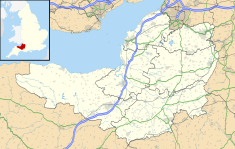
Montacute House is a late Elizabethan mansion in Montacute, South Somerset, England. An example of English architecture created during a period that was moving from the medieval Gothic to the more classically-inspired Renaissance style, Montacute is one of the few prodigy houses to have survived almost unchanged from the Elizabethan era. The house has been designated as a Grade I listed building, and its gardens are also listed at the highest grade on the Register of Historic Parks and Gardens of Special Historic Interest in England.

Castle Cary is a market town and civil parish in south Somerset, England, 5 miles (8 km) north west of Wincanton and 8 miles (12.9 km) south of Shepton Mallet, at the foot of Lodge Hill and on the River Cary, a tributary of the Parrett.
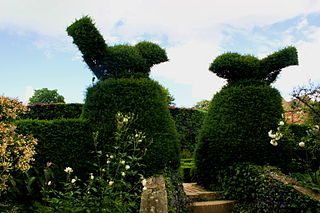
Hidcote Manor Garden is a garden in the United Kingdom, located at the village of Hidcote Bartrim, near Chipping Campden, Gloucestershire. It is one of the best-known and most influential Arts and Crafts gardens in Britain, with its linked "garden rooms" of hedges, rare trees, shrubs and herbaceous borders. Created by Lawrence Johnston, it is owned by the National Trust and is open to the public.
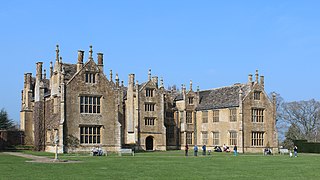
Barrington Court is a Tudor manor house begun around 1538 and completed in the late 1550s, with a vernacular stable court (1675), situated in Barrington, near Ilminster, Somerset, England.

Tintinhull is a village and civil parish near Yeovil, 2.5 miles (4 km) south west of Ilchester, in Somerset, England. The village is close to the A303. It is on the Fosse Way.

Hestercombe House is a historic country house in the parish of West Monkton in the Quantock Hills, near Taunton in Somerset, England. The house is a Grade II* listed building and the estate is Grade I listed on the English Heritage Register of Parks and Gardens of Special Historic Interest in England.

Gardens of the World with Audrey Hepburn was a 1993 documentary television series filmed on location in some of the world's most beautiful, noteworthy gardens, hosted by Audrey Hepburn, who also co-narrates the series with Michael York.

Lytes Cary is a manor house with associated chapel and gardens near Charlton Mackrell and Somerton in Somerset, England. The property, owned by the National Trust, has parts dating to the 14th century, with other sections dating to the 15th, 16th, 18th, and 20th centuries. "Yet all parts blend to perfection with one another and with the gentle sunny landscape that surrounds them," comments Nikolaus Pevsner. The House is listed as Grade I by English Heritage.

Stoke sub Hamdon Priory is a complex of buildings and ruins which initially formed a 14th-century college for the chantry chapel of St Nicholas, and later was the site of a farm in Stoke-sub-Hamdon, Somerset, England. The only building remaining from the college is a great hall and attached dwelling, dating from the late 15th century. The hall is designated by English Heritage as a Grade I listed building, while the outbuildings and gateway are Grade II listed. The whole site has been scheduled as an ancient monument. A number of the farm buildings are in poor condition, and have been added to the Heritage at Risk Register.

Hadspen House of Hadspen, Somerset, England is built of Cary stone, mined from Hadspen Quarry. The stone is a soft limestone known for its deep burnt-orange colour. It is an inferior oolite of the Garantiana Beds and dates to the Middle Jurassic. The house has been designated by English Heritage as a grade II* listed building.
Penelope Hobhouse MBE, née Chichester-Clark, is a British garden writer, designer, lecturer and television presenter.

The Grade I listed buildings in Somerset, England, demonstrate the history and diversity of its architecture. The ceremonial county of Somerset consists of a non-metropolitan county, administered by Somerset County Council, which is divided into five districts, and two unitary authorities. The districts of Somerset are West Somerset, South Somerset, Taunton Deane, Mendip and Sedgemoor. The two administratively independent unitary authorities, which were established on 1 April 1996 following the breakup of the county of Avon, are North Somerset and Bath and North East Somerset. These unitary authorities include areas that were once part of Somerset before the creation of Avon in 1974.
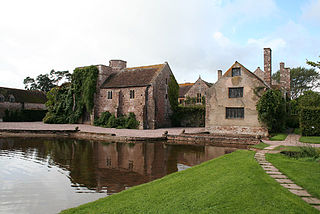
Cothay Manor is a grade one listed medieval house and gardens, in Stawley, near Wellington, Somerset. The manor grounds consist of almost 40 acres and include cottages, outbuildings, stables, and 12 acres of gardens.

In gardening, a garden room is a secluded and partly enclosed space within a garden that creates a room-like effect. Such spaces have been part of garden design for centuries. Generally they are regarded as different from terraces and patios just outside a building, although in practice these are often the parts of a garden that are most used as a room, with tables and chairs. Walls and hedges may form part of the boundaries of a garden room, but plants, usually at least a few feet tall, will do as well. Apart from the entrances to the room, these should normally enclose the space. There may be furniture, especially for sitting down, but this is not essential.
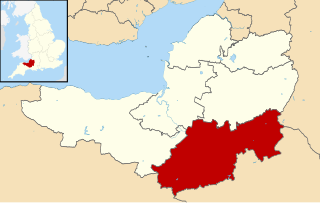
South Somerset is a local government district in the English county of Somerset. The South Somerset district occupies an area of 370 square miles (958 km2), stretching from its borders with Devon and Dorset to the edge of the Somerset Levels. The district has a population of about 158,000, and has Yeovil as its administrative centre.

Tintinhull Court in Tintinhull, Somerset, England, was built as a medieval parsonage for the Church of St Margaret. It has been designated as a Grade I listed building.

Montacute Priory was a Cluniac priory of the Benedictine order in Montacute, Somerset, England.

Phyllis Emily Reiss born Phyllis Emily Lucas was a British garden designer noted for her work at her own Tintinhull Garden, and Montacute House.

